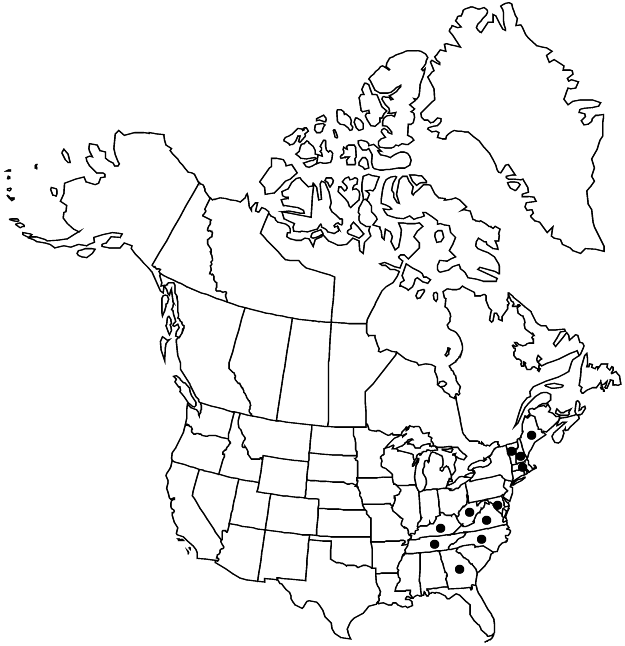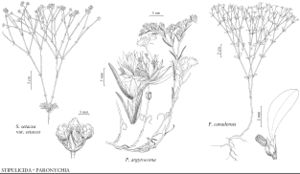Difference between revisions of "Paronychia argyrocoma"
Gen. N. Amer. Pl. 1: 160. 1818.
FNA>Volume Importer |
FNA>Volume Importer |
||
| Line 11: | Line 11: | ||
|name=Anychia argyrocoma | |name=Anychia argyrocoma | ||
|authority=Michaux | |authority=Michaux | ||
| + | |rank=species | ||
|publication_title=Fl. Bor.-Amer. | |publication_title=Fl. Bor.-Amer. | ||
|publication_place=1: 113. 1803 | |publication_place=1: 113. 1803 | ||
| Line 17: | Line 18: | ||
|name=Paronychia argyrocoma subsp. albimontana | |name=Paronychia argyrocoma subsp. albimontana | ||
|authority=(Fernald) Maguire | |authority=(Fernald) Maguire | ||
| + | |rank=subspecies | ||
}} {{Treatment/ID/Synonym | }} {{Treatment/ID/Synonym | ||
|name=Paronychia argyrocoma var. albimontana | |name=Paronychia argyrocoma var. albimontana | ||
|authority=Fernald | |authority=Fernald | ||
| + | |rank=variety | ||
}} | }} | ||
|hierarchy=Caryophyllaceae;Caryophyllaceae subfam. Paronychioideae;Paronychia;Paronychia argyrocoma | |hierarchy=Caryophyllaceae;Caryophyllaceae subfam. Paronychioideae;Paronychia;Paronychia argyrocoma | ||
| Line 44: | Line 47: | ||
-->{{#Taxon: | -->{{#Taxon: | ||
name=Paronychia argyrocoma | name=Paronychia argyrocoma | ||
| − | |||
|authority=(Michaux) Nuttall | |authority=(Michaux) Nuttall | ||
|rank=species | |rank=species | ||
| Line 59: | Line 61: | ||
|publication year=1818 | |publication year=1818 | ||
|special status= | |special status= | ||
| − | |source xml=https://jpend@bitbucket.org/aafc-mbb/fna-data-curation.git/src/ | + | |source xml=https://jpend@bitbucket.org/aafc-mbb/fna-data-curation.git/src/f50eec43f223ca0e34566be0b046453a0960e173/coarse_grained_fna_xml/V5/V5_55.xml |
|subfamily=Caryophyllaceae subfam. Paronychioideae | |subfamily=Caryophyllaceae subfam. Paronychioideae | ||
|genus=Paronychia | |genus=Paronychia | ||
Revision as of 21:54, 16 December 2019
Plants perennial, matted; caudex woody. Stems prostrate to ascending, much-branched, 5–60 cm, often retrorsely pubescent on 1 side. Leaves: stipules lanceolate, 2.5–8 mm, apex acute, entire; blade linear to linear-lanceolate or -oblanceolate, 5–30 × 0.5–2 mm, leathery, apex acute, often mucronate, sparsely appressed-pubescent. Cymes terminal, 15–25+-flowered, very compact, forming conspicuous glomerules 10–20 mm wide. Flowers 5-merous, short-cylindric to ovoid, with enlarged hypanthium and calyx cylindric to tapering distally, 3.5–6.5 mm, pubescent with antrorse, slightly spreading, silky hairs; sepals greenish to brownish, veins 3, obscure, ribs absent, narrowly lanceolate, 2–3.2 mm, leathery to rigid, margins translucent, ca. 0.1 mm wide, scarious, apex terminated by awn, hood narrowly triangular, awn straight to slightly divergent, white, 0.9–2 mm, scabrous, spinose; staminodes narrowly triangular, 0.4–0.6 mm; style 1, cleft in distal 1/6, 1.4–2 mm. Utricles oblong, 1.5–1.8 mm, smooth, pubescent distally.
Phenology: Flowering spring–early fall.
Habitat: On or among rocks
Elevation: 200-1800 m
Distribution

Ga., Ky., Maine, Md., Mass., N.H., N.C., Tenn., Vt., Va., W.Va.
Discussion
Plants of Paronychia argyrocoma with glabrous or barely scabrous leaves and glabrous sepal awns have sometimes been recognized as var. albimontana. They are found in both the southern and northern areas of the species range, but, curiously, not in the central portion (M. N. Chaudhri 1968).
Selected References
None.
